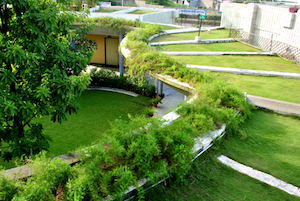
If you are wondering why you haven't read or heard about more litigation related to green projects, we have some ideas about why. If you think you can drop your guard and forget about the risks involved, please don't. The first reason we haven't seen more sustainable project disputes and litigation is that the world-
wide economic disruption has slowed green development. Today, most green projects involve higher costs for which financing is more difficult to obtain or that owners may be unwilling or unable to pay. On federal projects, for instance, a cost-benefit analysis must be completed prior to pursuing green techniques for the Dept. of Defense.
There are other reasons. Attorneys, brokers and insurance carriers have done a lot to raise awareness about the risks, which some choose to avoid or address via scope. With knowledge of the risks and the awareness that insurance probably won't cover missing a desired rating or standard, design and construction teams likely are drafting more effective and appropriate contracts (including scope) to lessen the potential for litigation.
Another reason is the lack of a financial incentive to litigate for something such as, say, failing to achieve a LEED Platinum rating and having to settle for Gold. Remember, if a client sues a designer, proceeds are not available under most design-professional liability policies given their fairly standard warranty and guarantee exclusions. Thus, the client would have to receive money directly from the design-and-construction team, which comprises numerous parties, when all potentially responsible parties are included. It's not different from traditional design-construct issues, but there is less precedent and less certainty, given limited prior litigation.
Control the Risks
That being said, the risks are real and need to be controlled.
 |
| MANGOLD |
Require the owner to hire someone with training in health and safety to advise the team on how to handle the potential risks of new technologies and methods. Be sure the contractor retains the responsibility for jobsite health and safety.
Don't assume responsibility for the operational performance of a building or its maintenance. Owners are not always seeing a reasonable payback from paying for projects that have a high level of energy efficiency.
 |
| KOPPLIN |
The design professional may do everything she thinks is required for the building to meet the requirements of Gold certification, but because the final determination is beyond her control, the designer should not guarantee the results by making it a contract requirement. Generally, they are not insurable.
Everyone has the responsibility to use the resources of this planet in a responsible manner. The green movement will be with us for many years and will only increase in importance because of concerns about climate change. Be aware of the risks associated with green design and protect yourself accordingly.
When will we see more green litigation? This will occur if and when green requirements are a part of new or updated codes and laws, such as the International Green Construction Code (IgCC). Integrated project delivery or other single-point-of-responsibility project delivery systems also could raise the quantum of litigation. That said, projects of only certain types and sizes lead to alternative project delivery.
If we don't see many green lawsuits for a while, it will be because of the economy, the cost of litigation or because we did a good job of dealing with those risks—not because the risks didn't exist in the first place.
Glen R. Mangold is managing director for the architects-engineers program for Markel Corp. and can be reached at gmangold@MarkelCorp.com. Charles W. Kopplin has more than 40 years of experience as a consulting engineer and can be reached at cw.kopplin@gmail.com.

Post a comment to this article
Report Abusive Comment